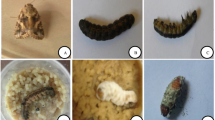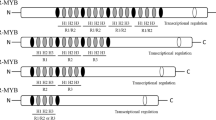Abstract
To identify novel virulence associated genes in Xanthomonas oryzae pv. oryzae (Xoo), a Xoo isolate (XooIR42), obtained from north of Iran, was selected to generate a mini-Tn5 transposon mutation library. One mutant (XooM176) that indicated reduced virulence on rice plants, while grew similar to wild type was selected. This mutant had an insertion in a coding region with 96 % amino acid identity to a response regulator of Xoo KACC10331, citB (Xoo_RS12710). Genome analysis of Xoo KACC10331 indicated several genes including a flagelin protein (FlgL) and a chemotaxis protein (Xoo_RS12720) which were identified as virulence genes 4297 and 1403 nucleotides from the citB, respectively. The swarming motility, resistance to hydrogen peroxide, induced a hypersensitive response, in planta growth and pathogenicity were reduced in XooM176 mutant compared to that of wild-type. A plasmid containing the full citB gene of Xoo KACC10331was sufficient to complement the XooM176 mutant for lesion formation and resistance to hydrogen peroxide. We therefore propose that Xoo requires CitB for full pathogenicity in rice plants and also for protection against oxidative stress.







Similar content being viewed by others
References
Ausubel FM, Brent R, Kingston RE, Moore DD, Seidman JG (1996) Current protocols in molecular biology. John Wiley and Sons, Inc, NY
Boyle-Vavra S, Yin S, Jo DS, Montgomery CP, Daum RS (2013) VraT/YvqF is required for methicillin resistance and activation of the VraSR regulon in Staphylococcus aureus. Anti Agent Chem 57:83–95
Burdman S, Shen Y, Lee SW, Xue Q, Ronald P (2004) RaxH/RaxR: a two-component regulatory system in Xanthomonas oryzae pv. oryzae required for AvrXa21 activity. M P M I 17:602–612
Büttner D, Bonas U (2010) Regulation and secretion of Xanthomonas virulence factors. FEMS Microb Rev 34:107–133
Cho HS, Pelton JG, Yan D, Kustu S, Wemmer DE (2001) Phosphoaspartates in bacterial signal transduction. Curr Opin Struc Biol 11:679–684
Cornelis P, Anjaiah V, Koedam N, Delfosse P, Jacques P, Thonart P, Neirinckx L (1992) Stability, frequency and multiplicity of transposon insertions in the pyoverdine region in the chromosome of different fluorescent pseudomonads. J G Microb 138:1337–1343
De Lorenzo V, Timmis KN (1994) Analysis of stable phenotypes in gram-negative bacteria with Tn5- and Tn10-derived minitransposons. Meth Enzym 235:386–405
Farr SB, Kogoma T (1991) Oxidative stress responses in Escherichia coli and Salmonella typhimurium. Microb Rev 55:561–585
Ghosh A, Dey N, Bera A, Tiwari A, Sathyaniranjan K, Chakrabarti K, Chattopad H (2010) Culture independent molecular analysis of bacterial communities in the mangrove sediment of sundarban, India. Sal syst 6:1–11
Huang TP, Lu KM, Chen YH (2013) A novel two-component response regulator links rpf with biofilm formation and virulence of Xanthomonas axonopodis pv. citri. PLoS ONE 23:e62824
Ikawa Y, Furutani A, Hirokazu O, Seiji T (2014) StoS, a hybrid histidine kinase sensor of Xanthomonas oryzae pv. oryzae, is activated by sensing low O2 concentration and is involved in stress tolerance and virulence. M P M I 27:537–545
Jacobs MA, Alwood A, Thaipisuttikul I, Spencer D, Haugen E, Ernst S (2003) Comprehensive transposon mutant library of Pseudomonas aeruginosa. P N A S 100:14339–14344
Jittawuttipoka T, Sallabhan R, Vattanaviboon P, Fuangthong M, Mongkolsuk S (2010) Mutations of ferric uptake regulator (fur) impair iron homeostasis, growth, oxidative stress survival, and virulence of Xanthomonas campestris pv. campestris. Arch Microb 192:331–339
Kauffman HE, Reddy APK, Hsiek SPY, Merca SD (1973) An improved technique for evaluation of resistant rice varieties to Xanthomonas oryzae. Plant Dis Rep 57:537–541
Kinscherf TG, Willis DK (1999) Swarming by Pseudomonas syringae B728a requires gacS (lemA) and gacA but not the acylhomoserin lactone biosynthetic gene ahlI. J Bacteriol 181:4133–4136
Kirchberg J, Buttner D, Thiemer B, Sawers R (2012) Aconitase B is required for optimal growth of Xanthomonas campestris pv. vesicatoria in pepper plants. PLoS ONE 7:e3491
Lee SW, Jeong KS, Han SW, Lee SE, Phee BK, Hahn TR, Ronald P (2008) The Xanthomonas oryzae pv. oryzae PhoPQ two-component system is required for AvrXA21 activity, hrpG expression, and virulence. J Bacteriol 190:2183–2197
Mew TW, Alvarez AM, Leach JE, Swings J (1993) Focus on bacterial blight of rice. Plant Dis 77:5–12
Nino-Liu DO, Ronald PC, Bogdanove AJ (2006) Xanthomonas oryzae pathovars: model pathogens of a model crop. Mol Plan Pathol 7:303–324
Ochman H, Gerber AS, Hartl DL (1988) Genetic applications of an inverse polymerase chain reaction. Genet 120:621–625
Park YJ, Song ES, Noh TH, Kim H, Yang KS, Hahn JH, Kang HW, Lee BM (2009) Virulence analysis and gene expression profiling of the pigment-deficient mutant of Xanthomonas oryzae pathovar oryzae. FEMS Microb Let 301:149–155
Parkinson JS, Kofoid EC (1992) Communication modules in bacterial signaling proteins. Ann Rev Genet 26:71–112
Pradhan BB, Ranjan M, Chatterjee S (2012) A novel adhesin of Xanthomonas oryzae pv. oryzae, exhibits similarity to Rhs family proteins and is required for optimum attachment, biofilm formation, and virulence. M P M I 25:1157–1170
Rico A, Preston GM (2008) Pseudomonas syringae pv. tomato DC3000 uses constitutive and apoplast-induced nutrient assimilation pathways to catabolize nutrients that are abundant in the tomato apoplast. M P M I 21:269–282
Schaad NW, Joneas JB, Chun C (2001) Laboratory Guid for identification of plant pathogenic bacteria, 3rd edn. APS press, MN
Shen Y, Ronald P (2002) Molecular determinants of disease and resistance in interactions of Xanthomonas oryzae pv. oryzae and rice. Microb Infec 4:1361–1367
Stock AM, Robinson VL, Goudreau PN (2000) Two-component signal transduction. Annu Rev Biochem 69:183–215
Subramoni S, Pandey A, Vishnu-Priya MR, Patel HK, Sonti RV (2012) The ColRS system of Xanthomonas oryzae pv. oryzae is required for virulence and growth in iron-limiting conditions. Mol Plan Path 13:690–703
Swings J, Van den Moore M, Vauteri L, Hoste B, Gillis M, Mew TW, Kersters K (1990) Reclassification of the causal agents of bacterial blight (Xanthomonas campestris pv. oryzae) and bacterial leaf streak (Xanthomonas campestris pv. oryzicola) of rice as pathovars of Xanthomonas oryzae. Int J Sys Bacteriol 40:309–311
Tamir-Ariel D, Rosenberg T, Burdman S (2011) The Xanthomonas campestris pv. vesicatoria citH gene is expressed early in the infection process of tomato and is positively regulated by the TctDE two-component regulatory system. Mol Plan Pathol 12:57–71
Tarighi S, Taheri P (2011) The role of a periplasmic gluconolactonase (PpgL)-like protein in Pseudomonas syringae pv. syringae B728a. W J Microb Biotech 27:1303–1311
Tian F, Yu C, Li H, Wu X, Li B, Chen H, Wu M, He C (2015) Alternative sigma factor RpoN2 is required for flagellar motility and full virulence of Xanthomonas oryzae pv. oryzae. Microbiol Res 170:177–183
Voelker LL, Dybvig K (1998) Demonstration of extrachromosomal elements. Meth Mol Bio 104:239–246
Wang JC, So BH, Kim JH, Park YJ, Lee BM, Kang HW (2008) Genome-wide identification of pathogenicity genes in Xanthomonas oryzae pv. oryzae by transposon mutagenesis. Plant Path 57:1136–1145
Wisedchaisri G, Wu G, Sherman DR, Hol WJ (2008) Crystal structures of the response regulator DosR from Mycobacterium tuberculosis suggests a helix rearrangement mechanism for phosphorylation activation. J Mol Biol 378:227–242
Xu J, Wu M, He C, Wei S, Wu XB (2010) Identification and functional analysis of TdrXoo, the member of TonB-dependent-receptor family proteins in Xanthomonas oryzae pv. oryzae. J Bacteriol 50:155–161
Yang F, Tian F, Sun L, Chen H, Wu M, Yang CH, He C (2012) A novel two-component system PdeK/PdeR regulates c-di-GMP turnover and virulence of Xanthomonas oryzae pv. oryzae. M P M I 25:1361–1369
Zou LF, Wang XP, Xiang Y, Zhang B, Li YR, Xiao YL, Wang JS, Walmsley AR, Chen GY (2006) Elucidation of the hrp clusters of Xanthomonas oryzae pv. oryzicola that control the hypersensitive response in non-host tobacco and pathogenicity in susceptible host rice. App Environ Microbiol 72:6212–6224
Acknowledgments
This work was supported by Ferdowsi University of Mashhad (project no. 3/23852). We thanks Dr. Sandra Williams for her technical supports and critical reading of the manuscript.
Author information
Authors and Affiliations
Corresponding author
Ethics declarations
Conflict of interests
The authors have declared no conflict of interest.
Informed consent
The authors are responsible for the content and consent to submit the manuscript to world journal of microbiology and biotechnology.
Rights and permissions
About this article
Cite this article
Sahebi, M., Taheri, E. & Tarighi, S. CitB is required for full virulence of Xanthomonas oryzae pv. oryzae . World J Microbiol Biotechnol 31, 1619–1627 (2015). https://doi.org/10.1007/s11274-015-1914-2
Received:
Accepted:
Published:
Issue Date:
DOI: https://doi.org/10.1007/s11274-015-1914-2




